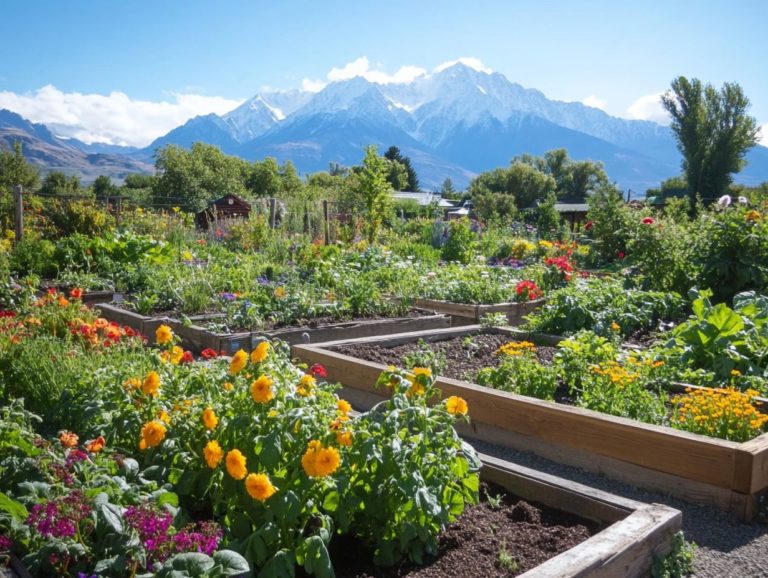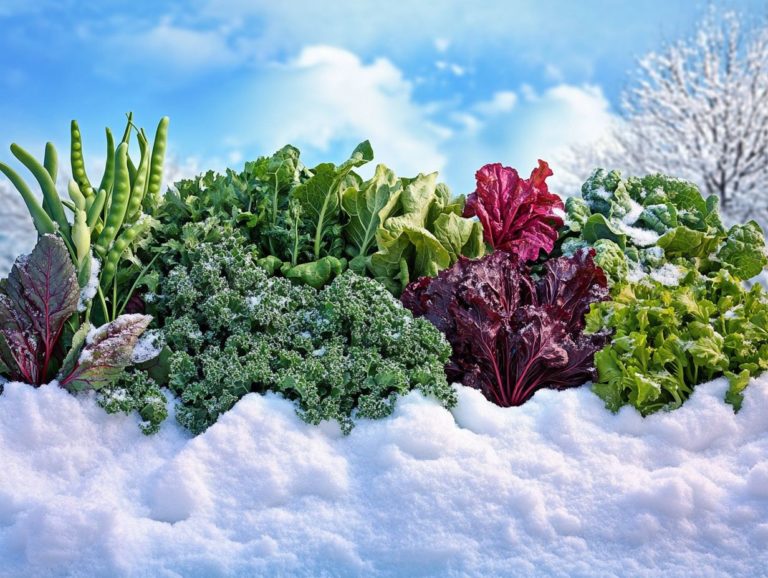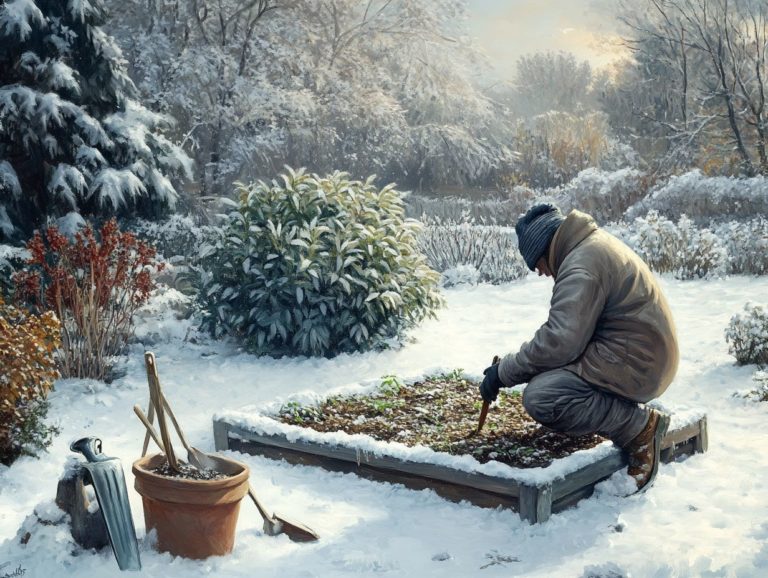Vegetables That Thrive in Cold Weather
As winter draws near, you might find yourself pondering which vegetables can brave the chill and still thrive! Don t wait! Start planning your winter garden today for a healthy harvest!
This article delves into a selection of robust vegetables that flourish in cold weather, ranging from vibrant leafy greens to resilient root vegetables.
Uncover the finest options for your winter garden, learn how to cultivate them effectively, explore their nutritional benefits, and gather tips on seamlessly incorporating them into your meals.
Embrace the season s bounty and savor the pleasure of fresh produce, even amidst the frost!
Contents
- Key Takeaways:
- 1. Leafy Greens
- 2. Broccoli
- 3. Cauliflower
- 4. Brussels Sprouts
- 5. Carrots
- 6. Beets
- 7. Radishes
- 8. Cabbage
- 9. Kale
- 10. Spinach
- 11. Lettuce
- 12. Swiss Chard
- 13. Turnips
- 14. Parsnips
- 15. Onions
- What Makes These Vegetables Ideal for Cold Weather?
- Frequently Asked Questions
- What are some vegetables that thrive in cold weather?
- Can I plant vegetables that thrive in cold weather in the fall?
- What is the ideal temperature range for vegetables that thrive in cold weather?
- How often should I water vegetables that thrive in cold weather?
- Can I grow vegetables that thrive in cold weather in containers?
- Do I need to use any special techniques to protect vegetables that thrive in cold weather?
Key Takeaways:
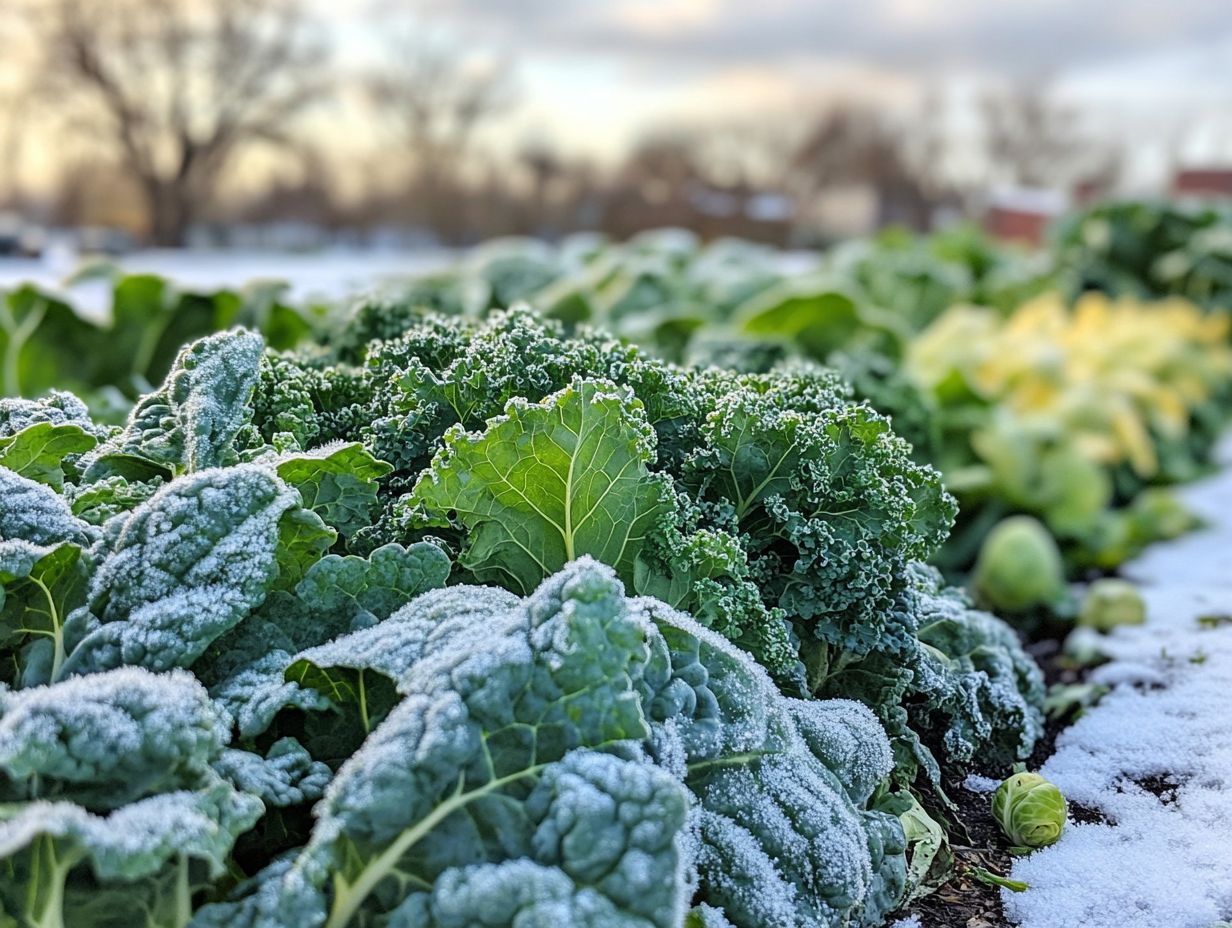
- Leafy greens, broccoli, and cauliflower are great options for cold weather gardening.
- These vegetables are rich in nutrients and can be easily grown in various climates.
- Incorporating these vegetables into your diet boosts your immune system and provides numerous health benefits.
1. Leafy Greens
Leafy greens are among the most versatile and nutritious crops you can cultivate in your vegetable garden. They are especially suited for cold weather planting.
These cool-season vegetables thrive in lower temperatures, making them perfect candidates for early spring planting and late fall harvests. Varieties like spinach, kale, and arugula are not only robust but also brimming with essential nutrients, significantly enhancing your diet.
Their ability to withstand frost enables them to thrive in less-than-ideal conditions, offering ample opportunities for those seeking a low-maintenance garden to enjoy a bountiful harvest.
Take spinach, for example. It thrives in well-drained soil and can be sown directly in the ground or started indoors before the last frost. Its rapid growth makes it an excellent choice for quick, successive harvests.
Kale, with its hearty leaves, flourishes in fertile soil and appreciates a balanced fertilizer. Both of these greens provide incredible health benefits, boasting high levels of vitamins A, C, and K, as well as being excellent sources of iron and calcium.
For optimal gardening success, ensure consistent moisture without waterlogging the soil. Mulching helps retain moisture and suppress weeds, thus enhancing your low-maintenance gardens.
2. Broccoli
Broccoli stands out as a cherished cool season vegetable, celebrated for its remarkable nutritional value and resilience in chilly conditions, making it a staple among vegetable types for winter gardening.
To flourish, it thrives in well-drained, nutrient-rich soil with a pH ranging from 6.0 to 7.0, ideally when temperatures hover between 60 F and 70 F.
If you’re aiming to cultivate healthy broccoli, maintaining consistent moisture is crucial just be cautious to avoid waterlogged conditions.
Regarding planting, you can either sow seeds directly in the ground or start them indoors; just ensure you provide ample space for the plants to develop those robust heads.
Keep a vigilant eye out for pests, and consider applying organic mulch to suppress weeds while retaining soil moisture.
Harvest those broccoli heads when they feel firm and tight, as they not only enhance your meals but also deliver a treasure trove of health benefits, including high levels of vitamins C and K, which are crucial during harvest time.
3. Cauliflower
Cauliflower, a versatile and nutrient-rich vegetable, is often your go-to choice for thriving in the cooler months of the gardening season.
To successfully cultivate this cruciferous gem, it s essential to grasp its specific growing needs. Cauliflower flourishes in well-drained, fertile soil with a pH level between 6.0 and 7.0, fostering healthy root development essential for its growth.
Consistent watering is paramount; your plant will require about 1 to 1.5 inches of water per week, especially during dry spells. Adding mulch around the base not only helps retain moisture but also regulates soil temperature, giving your cauliflower a cozy environment.
You might encounter challenges along the way, like pesky aphids or cabbage worms, or even conditions leading to bolting , where the plant flowers prematurely. By keeping a vigilant eye and providing steady care, you can reap the rewards of a bountiful cauliflower harvest.
4. Brussels Sprouts
Brussels sprouts are an amazing vegetable packed with nutrition! They thrive in cool weather, making them a fantastic choice for your cold-weather garden. They can withstand light frosts, which may even enhance their flavor, transforming these little green gems into a sweet, nutty delight that many people come to adore.
The ideal planting times typically fall in early spring or late summer, depending on your climate zone. This ensures they reach maturity just as temperatures start to dip.
To cultivate these sprouts successfully, provide consistent watering, ensure the soil is well-drained, and apply fertilizer occasionally to support their growth.
Brussels sprouts are also delicious food! Whether roasted, saut ed, or steamed, they deliver a healthy boost of vitamins and minerals, making them perfect for those hearty winter meals.
5. Carrots
Carrots are a timeless root vegetable that flourishes in cooler weather and offers a treasure trove of health benefits, making them a gardener s top choice. These vibrant delights come in different colors orange, purple, yellow, and even white each showcasing its own distinct flavors and textures.
For optimal growth, they thrive in well-drained, loamy soil enriched with organic matter. They ideally bask in full sunlight to soak up plenty of warmth and light. When planting, remember to space the seeds thoughtfully to prevent overcrowding, which can hinder their growth.
Regular watering and a bit of weeding will go a long way in maintaining their health. Harvesting typically occurs when the roots reach about an inch or two in diameter, ensuring they re sweet and tender.
These nutritious vegetables aren t just a feast for the palate; they re also packed with vitamins and minerals like beta-carotene, supporting eye health and contributing to a well-rounded diet.
6. Beets
Beets are a robust root vegetable that flourishes in cool weather. They blend delectable flavor with impressive nutritional value, making them an excellent choice for your cold-weather crops gardening endeavors.
To cultivate this versatile crop effectively, ensure your soil is well-drained and fertile, enriched with organic matter. Aim for a soil pH between 6.0 and 7.0 to promote optimal growth, resulting in beets that are not only substantial but also delightfully sweet.
Consistency in watering is key; these veggies thrive on about an inch of moisture each week, especially during dry spells. You can sow seeds directly into the ground in early spring or late summer, depending on your climate.
Regular weeding, along with a layer of mulch, will help maintain moisture and keep unwanted growth at bay. Once your beet tops are vibrant and the bulbs have reached at least two inches in diameter, they re ready for harvest an exquisite addition to salads, soups, or as a roasted side dish.
7. Radishes
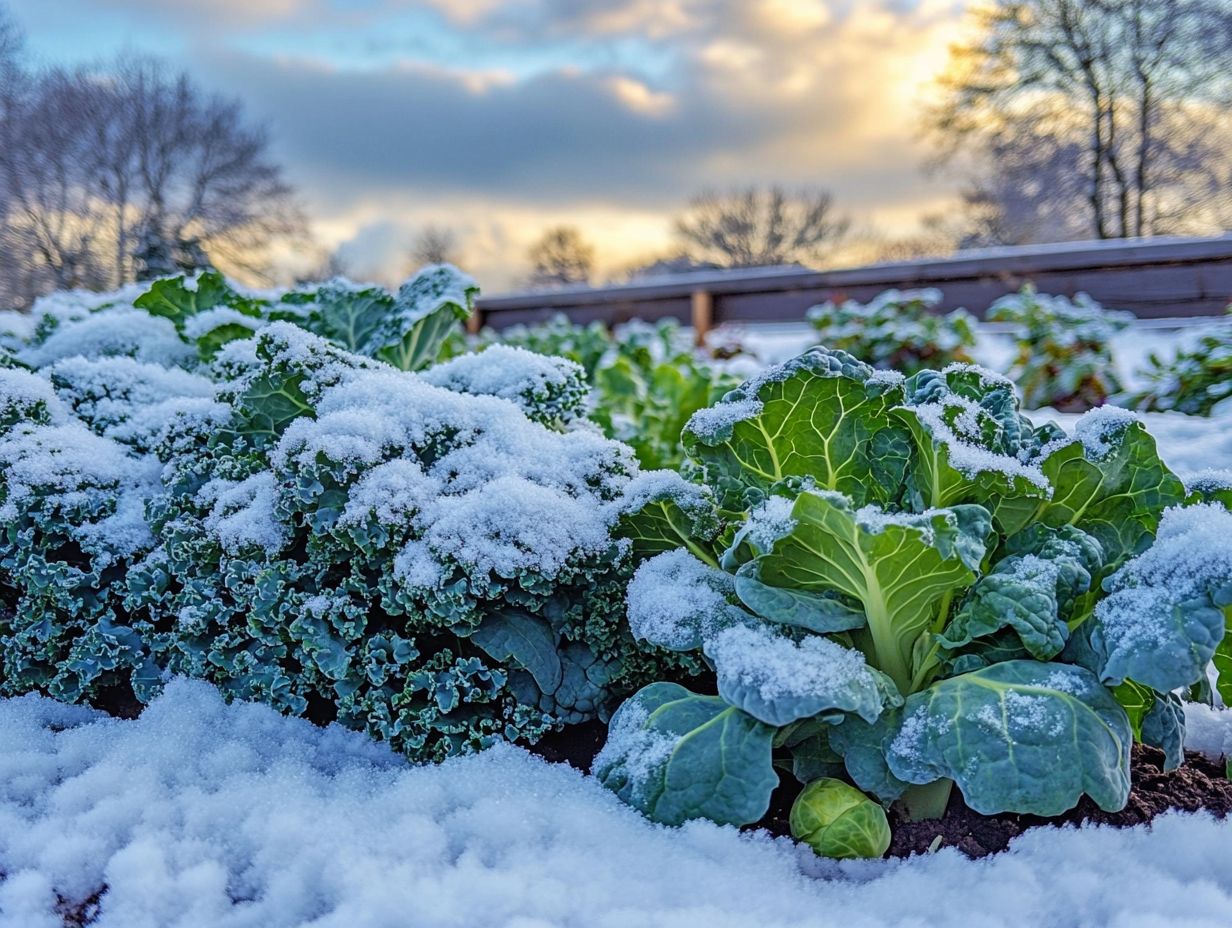
Radishes stand out as one of the fastest-growing cool-season vegetables, making them an ideal choice for anyone seeking low-maintenance gardening options.
These striking root vegetables come in a delightful array of varieties, including the classic red globe radish, the zesty daikon, and the crisp, mild French breakfast radish. They prefer well-drained soil and thrive in moderate temperatures ranging from 50 F to 70 F.
When planting, ensure you sow the seeds about half an inch deep and allow enough space for their growth. Regular watering, particularly during dry spells, will significantly aid in their speedy development.
Timely harvesting is crucial to preventing them from becoming woody. Packed with vitamins and antioxidants, radishes offer impressive health benefits, promoting digestion and supporting overall wellness.
8. Cabbage
Cabbage is a tough and tasty vegetable! It flourishes in cooler temperatures, offering culinary versatility and impressive nutritional benefits.
With various types at your disposal such as green, red, and savoy each variety boasts its distinct flavor and texture, along with specific growing requirements. Don t wait! Get your seeds in the ground this spring for a bountiful harvest.
Green cabbage thrives in fertile soil that retains moisture, while red cabbage prefers slightly drier conditions. The ideal approach is to plant seeds in early spring or late summer, ensuring they bask in ample sunlight for robust growth.
Regular watering is essential, along with mulching to keep weeds at bay and maintain the soil’s moisture levels. Cabbage integrates seamlessly into many cuisines, from refreshing coleslaw to the vibrant flavor of kimchi.
This adaptability and rich taste elevate a wide array of dishes, making cabbage a favorite among gardening editors and chefs alike.
Fun Fact: Did you know that cabbage is a member of the cruciferous family, which includes broccoli and kale?
9. Kale
Kale is a nutrient-rich vegetable among leafy greens. It thrives in cooler weather, making it a must-have for your cold-weather vegetable garden, particularly for those focused on gardening for health.
This vibrant green delights in well-drained, loamy soil enriched with organic matter. If you re planning to cultivate kale, aim for at least six hours of sunlight daily for optimal yield; however, in hotter regions, some partial shade can work wonders for your plants.
Caring for kale requires regular watering to keep the soil consistently moist, while a layer of mulch does double duty by retaining moisture and keeping weeds at bay. When it s time to harvest, feel free to pick the outer leaves selectively, encouraging continual growth.
In the kitchen, kale truly shines as a versatile ingredient. Whether tossed in salads, blended into smoothies, or saut ed as a side dish, it enriches your meals with its robust flavor and impressive health benefits.
Fun Fact: Kale was one of the most popular vegetables in the Middle Ages!
10. Spinach
Spinach is a versatile leafy green that thrives in cool weather, offering exceptional health benefits that make it an essential addition to your vegetable garden.
Understanding the ideal growing conditions for this esteemed plant is crucial. Spinach prefers well-drained, loamy soil rich in organic matter, ideally maintaining a pH between 6.5 and 7.5.
When planting, choose a spot that enjoys full sun to partial shade, particularly during warmer months, as excessive heat can stifle its growth. Adequate watering is key; the soil should remain consistently moist, but be careful to avoid waterlogging to prevent root rot.
To ensure a bountiful harvest, regularly check for pests and remove any weeds that might compete for nutrients. Harvest your spinach at the perfect time to enjoy its freshest flavor!
Fun Fact: Spinach was famously used by Popeye to gain strength!
11. Lettuce
Lettuce is a remarkably adaptable leafy green that thrives in cooler temperatures, making it an outstanding choice for your low-maintenance gardens in spring and fall.
With a delightful array of varieties from the crisp Romaine to the tender Butterhead each type brings its unique growing conditions and flavor profiles. Loose-leaf varieties can handle a bit of crowding, while head lettuces generally prefer a little more personal space to flourish.
When you plant, ensure your soil is rich in organic matter. Timing your sowing for early spring or late summer allows you to take full advantage of the cooler weather. Regular watering is essential, especially during dry spells, and your lettuce will appreciate some partial shade when temperatures rise.
As for harvesting, picking the outer leaves first encourages continued growth, ensuring a steady supply of fresh greens. In the kitchen, lettuce truly shines whether in salads, sandwiches, or wraps, it showcases its versatility and crisp texture beautifully.
Fun Fact: Lettuce was cultivated by the ancient Egyptians over 2,000 years ago!
12. Swiss Chard
Did you know Swiss chard can add a rainbow of colors to your plate? Swiss chard is a strikingly vibrant leafy green that thrives in cooler weather, offering you a colorful and full of nutrients addition to your vegetable garden.
This hardy plant, with its beautifully colorful stems and broad leaves, can adapt to a variety of soil types. It s an excellent choice whether you’re a novice or a seasoned gardener.
The best times to plant typically fall in early spring or late summer, ensuring you enjoy plenty of vegetables during those temperate conditions.
To optimize growth, make sure to provide well-draining soil that allows water to flow through easily, enriched with organic matter and plenty of sunlight.
Regular watering and timely harvesting keep your plants healthy and yield fresh, leafy greens bursting with vitamins A, C, and K. And let s not forget its versatility in the kitchen Swiss chard shines in salads, saut s, and soups, elevating any dish with both flavor and nutrition.
13. Turnips
Turnips are a fascinating root vegetable that flourishes in cooler weather, giving you both a tasty edible root and nutritious greens for your culinary creations.
These adaptable plants thrive in well-draining, loamy soil rich in organic matter, which is key to their growth and nutrient absorption. Keep the soil pH between 6.0 and 7.5 to allow turnips to soak up essential nutrients effectively.
To cultivate these delightful gems, sow the seeds directly into the ground in early spring or late summer, spacing them properly for good air circulation. Regular watering is vital, especially during dry spells, but be cautious overwatering can lead to rot.
When the roots reach about two to three inches in diameter, don t wait too long to harvest! They provide a satisfying crunch and flavor that can elevate a variety of dishes.
14. Parsnips
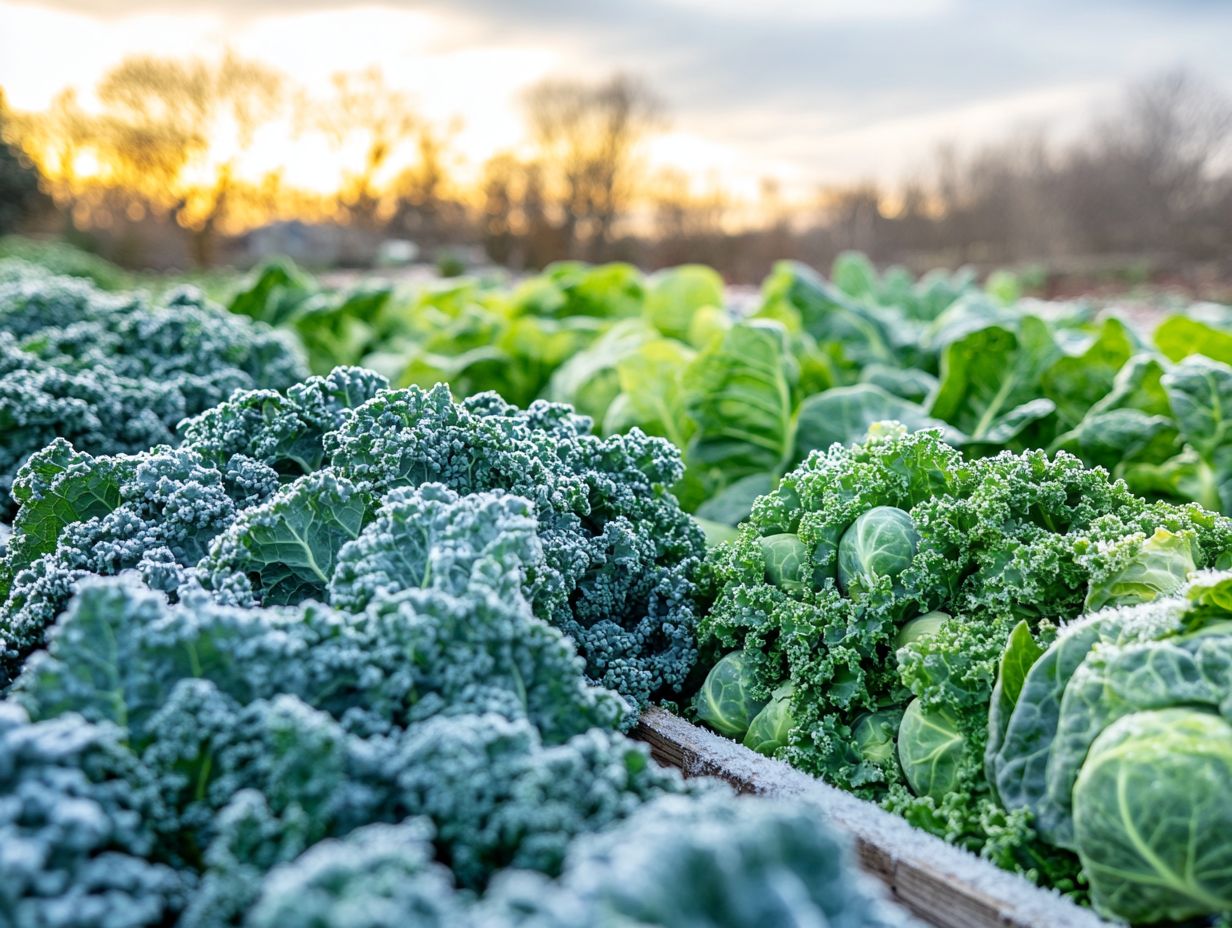
Parsnips are a full of nutrients root vegetable that thrives in cool weather, revealing a sweet flavor when harvested after a frost.
This resilient vegetable flourishes in well-drained, loamy or sandy soils with a pH between 6.0 and 7.0, allowing those long taproots to grow freely. Ideally, they should bask in full sun for at least six hours daily, though they can even thrive in some shade!
Regarding planting, you ll want to sow the seeds directly into the ground in spring or late summer, spacing them about an inch apart. Regular watering and weeding will support their growth, and a layer of mulch will help keep the soil moist.
For harvesting, timing is key wait until after the first fall frost. This little trick enhances their flavor, making them an exquisite addition to a variety of dishes.
15. Onions
Onions are a cornerstone of many vegetable gardens and can thrive beautifully in cooler weather, adding a burst of flavor to a myriad of dishes.
From the crispness of green onions to the delightful sweetness of yellow and red varieties, you have a spectrum of options that flourish when temperatures drop. Consider incorporating cool-weather onions like shallots and leeks into your garden; these choices not only diversify your harvest but also elevate your culinary creations.
For successful growth, ensure they have well-drained soil and plenty of sunlight. Regular watering and mulching will promote healthy bulb formation.
When it comes time to harvest, pay attention to the timing; waiting for the tops to turn yellow is your cue that it s the perfect moment to savor these versatile ingredients, transforming everything from soups to salads.
What Makes These Vegetables Ideal for Cold Weather?
Cold weather crops like leafy greens, root vegetables, and hardy varieties are perfectly suited to thrive in cooler climates. They offer a wealth of benefits for both you and your kitchen.
Their natural frost tolerance means they can withstand lower temperatures. This makes them reliable choices for extended harvests in the spring and fall.
It ensures a diverse, nutrient-rich selection in your garden. Plus, it promotes sustainable gardening practices by maximizing your growing seasons.
These vegetables often accumulate increased sugar content in response to cold stress. This acts as a natural antifreeze and enhances their flavor.
If you want to maximize yields from these resilient varieties, start seeds indoors for a valuable head start. Utilizing row covers provides extra insulation during chilly nights, protecting your crops from frost while still allowing sunlight to shine through.
Regularly mulching around the base of your plants helps regulate soil temperature and moisture. This promotes healthier growth.
By understanding these natural adaptations, you can significantly enhance your cold-weather gardening efforts. This leads to bountiful harvests even in less-than-ideal conditions.
How Can One Grow These Vegetables in Cold Weather?
Growing cold weather crops demands specific techniques and strategies to guarantee success. It all starts with thoughtful planning for indoor seed starting and the proper transplanting of seedlings.
Timing is crucial; ideally, you should sow your seeds indoors about six to eight weeks before the last frost date. By providing the right conditions like warm soil temperatures, adequate moisture, and sufficient light you ll encourage vigorous growth and robust seedlings.
Once your seedlings have established a strong root system and their first true leaves appear, it s important to acclimate them to outdoor conditions gradually. This process, known as hardening off, should unfold over one to two weeks.
Watch factors like soil temperature and unpredictable weather to ensure that when you transplant, your young plants are primed to thrive in their new environment.
What Are the Benefits of Eating Vegetables That Thrive in Cold Weather?
Eating vegetables that flourish in cold weather brings a wealth of health benefits. They are often brimming with nutrients and loaded with essential vitamins and minerals.
These hearty greens think kale, Brussels sprouts, and winter squash not only help boost your immune system, but they also serve as a rich source of antioxidants to fight off oxidative stress.
By incorporating these vegetables into your seasonal recipes, you can significantly elevate your nutrition. Picture a warm kale salad adorned with roasted nuts and a zesty citrus dressing; it s both satisfying and nourishing!
Or consider a comforting Brussels sprouts and sweet potato mash as a side dish perfect for the colder months while delivering essential nutrients. It s a delightful way to nurture both your body and soul.
Are There Any Vegetables That Should Be Avoided in Cold Weather?
While many vegetables thrive in cold weather, certain varieties are sensitive to frost and should be avoided during the chillier months.
Take tomatoes and peppers, for example; they re highly vulnerable and often suffer damage or fail to produce when temperatures dip. To safeguard these delicate plants, consider using row covers or cloches to shield them from harsh conditions.
Planting in raised beds can also improve drainage and help keep their roots warmer. If frost is a concern, think about alternatives that are better suited for colder climates.
Options like kale, spinach, and Brussels sprouts not only withstand chilly temperatures but also add a splash of vibrant colors and textures to your winter garden!
How Can One Incorporate These Vegetables into Their Diet?
Incorporating vegetables that grow well in cooler temperatures into your diet can be a delightful adventure, enriching your meals with a variety of flavors and cooking ideas.
By embracing the vibrant tastes of root vegetables like carrots, turnips, and parsnips, you can craft hearty stews, roasted dishes, and satisfying purees. These dishes not only tantalize your taste buds but also nourish your body. Imagine roasting a medley of these veggies with a drizzle of olive oil, a hint of thyme, and a sprinkle of sea salt; it transforms their natural sweetness into a perfect side dish that truly sings.
Choosing fresh, seasonal produce means you’re indulging in nutrients at their peak, paving the way for better health while supporting local agriculture. As you explore recipes featuring these ingredients, you’ll find inspiration that sparks your creativity in the kitchen. Start experimenting with these wonderful vegetables today!
Frequently Asked Questions
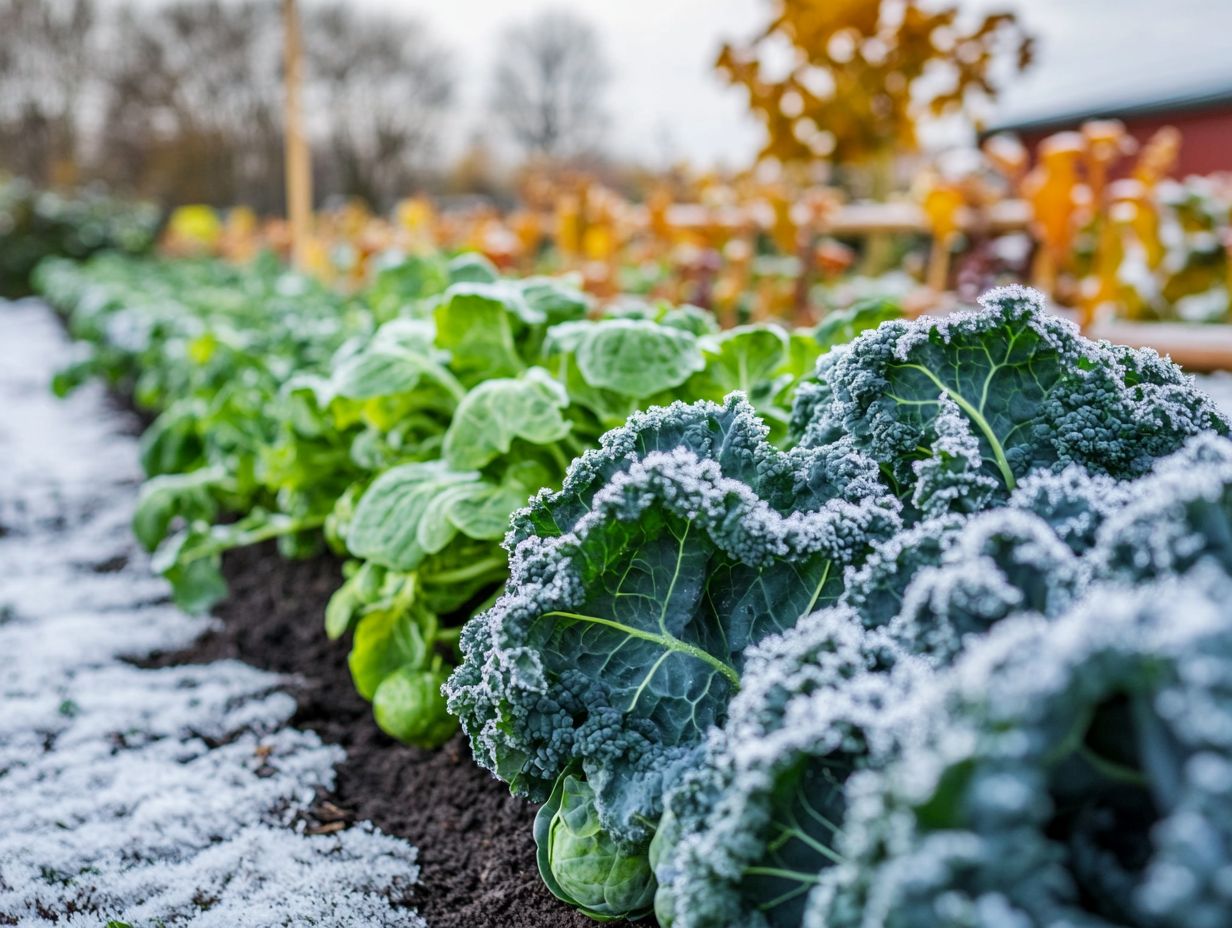
What are some vegetables that thrive in cold weather?
Some vegetables that thrive in cold weather include broccoli, kale, carrots, Brussels sprouts, spinach, and cauliflower.
Can I plant vegetables that thrive in cold weather in the fall?
Yes, fall is the perfect time to plant cold weather vegetables as they can withstand the colder temperatures and even taste better after a light frost.
What is the ideal temperature range for vegetables that thrive in cold weather?
Most cold weather vegetables prefer temperatures between 40-60 F, but some, like kale and Brussels sprouts, can withstand even colder temperatures.
How often should I water vegetables that thrive in cold weather?
Generally, vegetables that thrive in cold weather need about 1 inch of water per week. However, it’s important to check the soil moisture and adjust watering as needed.
Can I grow vegetables that thrive in cold weather in containers?
Yes, many cold weather vegetables can be grown in containers as long as they have enough space and proper drainage. Make sure to use a potting mix specifically for vegetables.
Do I need to use any special techniques to protect vegetables that thrive in cold weather?
Some cold weather vegetables, like carrots and beets, may benefit from a layer of mulch to protect them from freezing temperatures. Using a cold frame or row covers helps extend the growing season for these vegetables.

